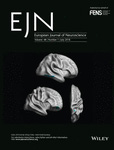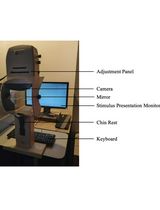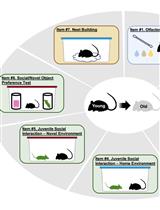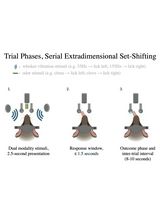- EN - English
- CN - 中文
Social Defeat Stress (SDS) in Mice: Using Swiss Mice as Resident
Swiss小鼠作为研究对象研究小鼠的社会失败应激(SDS)
发布: 2019年03月20日第9卷第6期 DOI: 10.21769/BioProtoc.3197 浏览次数: 6781
评审: Maheedhar KodaliCristina Isabel CarvalhoAnonymous reviewer(s)
Abstract
Due to the high prevalence and great economic impact of depression, studies with animal models have been increasingly used to identify neurobiological mechanisms associated with this disorder. However, many animal models use stressful conditions that are not consistent with what we observe in the modern human world. Examples are the chronic unpredictable stress and the electric shock model used in rodents. It’s well established the social stress as the major cause of depressive disorder in human, in this way a social defeat stress model was recently standardized and can induce depressive-like behavior of social avoidance, a typical human depressive behavior. In this model, mice are exposed on consecutive days to an aggressor mouse, suffering brief periods of physical aggression followed by longer periods of visual and olfactory (sensory) contact and, as a consequence, a relationship of social submission is characterized. Thus, the objective of this work is to describe a social defeat stress protocol using swiss mice as resident, also describing valuable procedural suggestions that will help researchers to reproduce the model easily.
Keywords: Social defeat stressBackground
Developing animal models that mimic human psychiatric disorders is a great challenge. The difficulty is from the induction of behavioral changes associated with the psychiatric condition to the evaluation or measurement of such behavior. Depression is a psychiatric disorder with high prevalence and, as a high cognitive complexity disorder, is hard to be assessed in animal models. Stress (mainly social stress) is already well established in the literature as a key factor for the establishment of depression (Kendler et al., 1999; Gold and Chrousos, 2002; Slavich and Irwin, 2014; Saleh et al., 2017), so it is not surprising that animal models of depression use some kind of stress.
One of these models is the chronic unpredictable stress. In this model, rodents are exposed to a series of stressful stimuli randomly presented for several weeks. Among the stressful stimuli are: periodic deprivation of water and/or food, exposure to low temperatures, physical restraint and reversal of the light/dark cycle. As a result, the rodent exhibit a depressive-like behavior called learned helplessness, which can be reversed with antidepressant drugs. However, questions about the reproducibility of these behavioral results have been raised mainly due to the great variability of protocols, which diminished confidence in the model (Pollak et al., 2010). In another animal model of depression, rodents are subjected to repeated and highly stressful electric shock sessions which generate a deficit in the aversive stimulus avoidance, a behavior typically considered as depressive. The great criticism for this model is that the depressive-like behavior does not persist after the end of electrical stimuli. These above-mentioned animal models of depression commonly use nonspecific tests to evaluate anhedonia and despair depressive-like behaviors which are commonly analyzed by the sucrose preference and forced swimming test, respectively.
In this scenario, the social defeat stress model was recently standardized and can induce depressive-like behavior of social avoidance in mice (Golden et al., 2011). In this model, mice are exposed on consecutive days to an aggressor mouse, suffering brief periods of physical aggression followed by longer periods of visual and olfactory (sensory) contact. After this period a relationship of social submission is characterized, typically observed in human relations. As a result, stressed mice develop several physiological and behavioral changes, including altered levels of corticosterone, cardiac hypertrophy, circadian rhythm disturbances, widespread pain, anxiety, despair behavior, anhedonia and social avoidance (Krishnan et al., 2007; Pagliusi et al., 2018). Social interaction level is used to assess depressive-like behavior and, interestingly, some mice submitted to this social defeat stress protocol are resistant and do not develop social avoidance, similar to what occurs in humans, where not all individuals exposed to some form of chronic social stress develops psychopathologies (Krishnan et al., 2007).
Another important feature of this model, which makes it much more reliable than the oldest animal models of depression and depressive-like behavior tests, is the fact that the social avoidance behavior can be reversed only to chronic, and not acute, treatments with antidepressant drugs, as also is observed in humans ( Berton et al., 2006; Berton and Nestler, 2006; Pollak et al., 2010). In addition, mice submitted to the SDS protocol exhibit neurobiological changes very similar to those found in humans with depression, including brain monoamines reduction, hypothalamic-pituitary-adrenal axis dysfunction, BDNF reduction in the hippocampus and BDNF increase in the nucleus accumbens (Hatzinger, 2000; Holsboer, 2001; Berton et al., 2006; Duman and Monteggia, 2006; Krishnan et al., 2007; Pittenger and Duman, 2008; Castrén and Rantamäki, 2010; Goldberg et al., 2014; Iñiguez et al., 2016). It is, therefore, a robust model that can induce symptoms very similar to human depression.
Thus, the objective of this work is to describe a social defeat stress protocol adapted from that described by Golden et al. (2011), since many laboratories can’t use the same materials and mice strain as those described in the original protocol. Therefore, we will describe how to use the Swiss mouse as an aggressor, since it is quite evident the natural aggressive behavior of this strain under the experimental conditions used in this protocol (Miczek et al., 2001). We will also describe valuable procedural suggestions that will help researchers to easily reproduce the model.
Materials and Reagents
- Cleaning wipes
- At least 40 Swiss mice
- C57BL/6J mouse
- Wood chip bedding
- Alcohol 40% (storage at room temperature)
Equipment
- Timer
- Mechanical tally counter
- Laboratory rat breeding cage (46.3 cm [d] x 30.5 cm [w] x 15.8 cm [h]) with wood chip bedding
- Perforated acrylic divider (43.7 cm [d] x 0.6 cm [w] x 15.8 cm [h]) that fits into the rat breeding cage and grid (see Notes)
- Social interaction arena (42 cm [d] x 42 cm [w] x 42 cm [h]) (see Notes)
- 1 perforated acrylic enclosure (6.5 cm [d] x 10 cm [w] x 42 cm [h]) per social interaction arena (see Notes)
- Video tracking apparatus
Software
- TopScan video tracking software (Clever Sys Inc., http://cleversysinc.com/)
Consider alternative software like EthoVision® XT (Noldus Information Technology, https://www.noldus.com/) - Prism 8.0 (GraphPad, https://www.graphpad.com/) or similar software to perform statistical analysis
Procedure
文章信息
版权信息
© 2019 The Authors; exclusive licensee Bio-protocol LLC.
如何引用
Pagliusi Jr., M. O. F. and Sartori, C. R. (2019). Social Defeat Stress (SDS) in Mice: Using Swiss Mice as Resident. Bio-protocol 9(6): e3197. DOI: 10.21769/BioProtoc.3197.
分类
神经科学 > 行为神经科学 > 认知
您对这篇实验方法有问题吗?
在此处发布您的问题,我们将邀请本文作者来回答。同时,我们会将您的问题发布到Bio-protocol Exchange,以便寻求社区成员的帮助。
Share
Bluesky
X
Copy link












